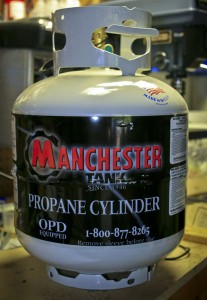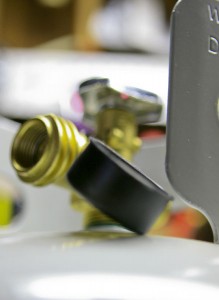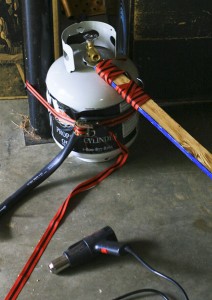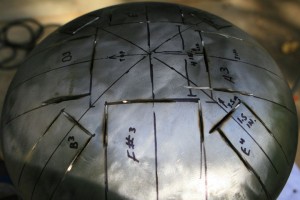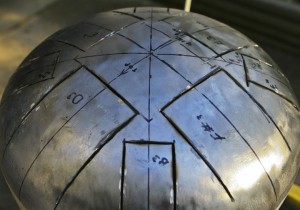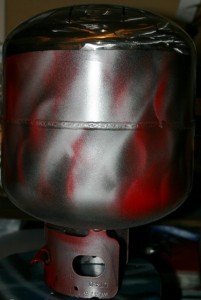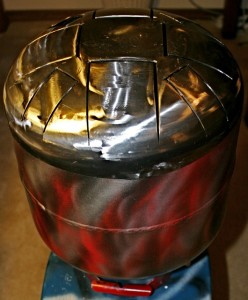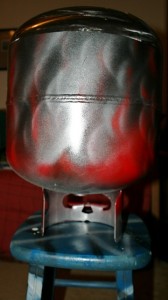My brother and I have always been interested in all types of percussion. One piece that we both geek out on is the Hang Drum. They have a very unique sound. If you are interested, here is a clip of a guy playing the hang. I decided that I would get my brother a hang for his birthday. I did some research and found the pricing. Once I picked my jaw up off the floor, I decided that perhaps I would not get a hang for his birthday. The things cost between $4,ooo up to $10,000. I love my brother, but that is too rich for my blood. So, being a maker of things, I set out to try to figure out how to make a hang. After a bit of searching, I stumbled onto a similar sounding instrument… The Hank. It can be purchased, but better, it can be made. It is a hang drum sounding instrument built out of a propane tank. There are various ideas about the how the name came into being. I prefer the theory that it is based on Hank Hill. Hank sells propane and propane accessories.
In my quest to look at everything I could find on the Hank, I saw many different ways of going about building it. I decided to base my build on the Hapi drum because when I listened to samples, the Hapi had some of the nicest tones. Some sites lay it all out on out how to build a hank drum with rounded tongues. I am not sure I totally agree with the shape while trying to keep a smooth vibration. The Hapi drums have more rectangular tongues. The only problem is that I did not see any plans on layout. So, I snagged a picture from the Hapi site and blew it up. I then decided on notes and found out what the frequencies were for each note. My theory was this… If sound holds true to it’s laws (which would be a problem if it didn’t), a longer tongue will have a lower pitch than a shorter one, so a template to trace from was irrelevant.

 First things first. I have read it elsewhere and I think it bears repeating…
First things first. I have read it elsewhere and I think it bears repeating…
DO NOT TRY THIS WITH A TANK THAT HAS EVER HAD PROPANE IN IT. IF YOU DO, MORE THAN LIKELY YOU WILL BLOW YOURSELF UP AND THAT WOULD BE REALLY SAD!!!
 I bought my empty tank from Home Depot. It was about $35. The first order of business was getting the stem out of it. I read many places that this would be difficult, and it was. I found one site that had the recommendation to heat up the stem with a heat gun. This will melt the glue that keeps it in place. This worked rather well. Plus, I attached a large plank to the wrench for extra torque. It was not a glamorous wrench mod, but function outweighed beauty. Once it started to move I kept it moving, but very slowly. There is difference of air pressure inside the tank. Eventually I heard a hiss. When the hissing stopped I finished unscrewing the stem. It had a large bulb thing on the end so it was a little goofy getting it out.
I bought my empty tank from Home Depot. It was about $35. The first order of business was getting the stem out of it. I read many places that this would be difficult, and it was. I found one site that had the recommendation to heat up the stem with a heat gun. This will melt the glue that keeps it in place. This worked rather well. Plus, I attached a large plank to the wrench for extra torque. It was not a glamorous wrench mod, but function outweighed beauty. Once it started to move I kept it moving, but very slowly. There is difference of air pressure inside the tank. Eventually I heard a hiss. When the hissing stopped I finished unscrewing the stem. It had a large bulb thing on the end so it was a little goofy getting it out.

The next thing I did was take the bottom ring off the bottom. I decided to use the angle grinder. It did a fine job of munching through the metal. Sidetrack… I need to throw out a word of warning to those who would set up, and take a picture of flying sparks. Sparks are pretty, yes, and do make for nice photos (although I am not so keen on this one), but sparks are sparks because they are hot. Very hot. Hot enough to melt into the UV filter sitting on the front of your camera. If you look at the filter (which I kept as a reminder) there are little bits of metal sticking out of it. The camera was about 4 feet away, and the sparks were still hot enough to burn into it. It was total confirmation as to why I put a protective glass UV filter on the front of the lens in the first place (aside from the obvious benefits of the UV filter). The decision between buying a new $70 filter, or a new $1,300 lens is an easy one.

Once I got the ring off, I grinded the bumps down to the surface. I continued by removing the paint. This was not as easy as I though it would be. That stuff is stuck on there really well. I went through 3 sanding disks to get down to metal. (Wear a mask as this stuff gets everywhere).

I started working on the layout and design. It was kind of a make it up as you go job. I got an X and Y baseline marked out, and measured out the area. I knew I was going to have 4 tabs in a cross pattern and 4 smaller tabs in an X pattern. The smaller tabs would be approximately an octave above the larger tabs so I decided to make the smaller tabs half of the width of the larger ones. I used a Sharpie to mark out the cutting pattern. I also wrote the note name and lay out.
I started to cut the tabs. cutting into it created beautiful fountains of sparks. I wanted to take pictures, I really did, but I was a little freaked out after the last little bit of sparkage. I used the angle grinder for the initial cuts, then switched over to the Dremel for the finer cuts. I use a Palm Treo. I have a very nice guitar tuner on it called Phone Tuner. Update: I am now using Android and am using gStrings for phone based tunings. It works great. I used it to tune the drum. I made cuts down the sides of the tungues, then I would tune. I totally goofed on one tongue and had to cut it down to pitch. This left a hole on the side, but it still played well, it just looks a little goofy. So I made smaller cuts and used the dremel a lot as it was much slower in cutting than the grinder. I would make several cuts then I would check the tuning. Then more cuts, then tune. It was a rather repetitive task, but eventually it started to come into tune. Several times I got side tracked playing the thing instead of cutting it.
Once the tuning was where I wanted it, I started into a final polish before I painted it. I wanted the top to stay the fresh brushed metal look, so it had to be really smooth. I used a fine sanding disk on the angle grinder. I spent a fair amount of time on this part. I would start at the very edges and spiral my way up to the center. If I goofed and lifted up, or got out of alignment, it was very obvious. I kept at it until I got a very shiny dome. The side effect of sanding a tuned drum, is that it makes a very loud ring. It was very cool. I would start on the edge and it would start with lower tones. As I moved closer to the center, the ring started revealing all sorts of harmonics. It was too loud for uncovered ears, but even with protection, it was beautiful.
I covered the top metal with several layers of clear coat so it wouldn’t rust. Once that was dry I masked off the top in prep for the bottom. I also plugged up the hole that the stem was in with a wad of paper towel so stray spray would not enter it. I went to crazy on the drum with silver, red, and black spray paint. I was trying to make flame sort of wisps. Having recently watched one of the over haulin’ type of shows, I got the idea of using a stencil mask. I started with aluminum foil that I could bend to all sorts of different shapes. Then I would spray at it and whatever missed the foil, would hit the Hank. Then after a few wisps were painted, I would bend it and paint again. The stupidity and shortsightedness lay in the fact that the paint on the foil would be wet when I bent it. Yeah, duh. After a while I switched to a pineapple can that had both ends cut out. This made some very nice shapes. Once I had covered it with far too much paint, I then went over it with a couple of layers of clear coat to add some protection to the paint. I figured that because it was a drum it would get dinged up rather quickly. I did not have time to take pictures as my brother came into town the day after I got done painting it. I had about enough time to run upstairs and hide it as he pulled into the driveway. He loved it. He said that it has actually gone on stage a few times. I asked him to take a few pix.

